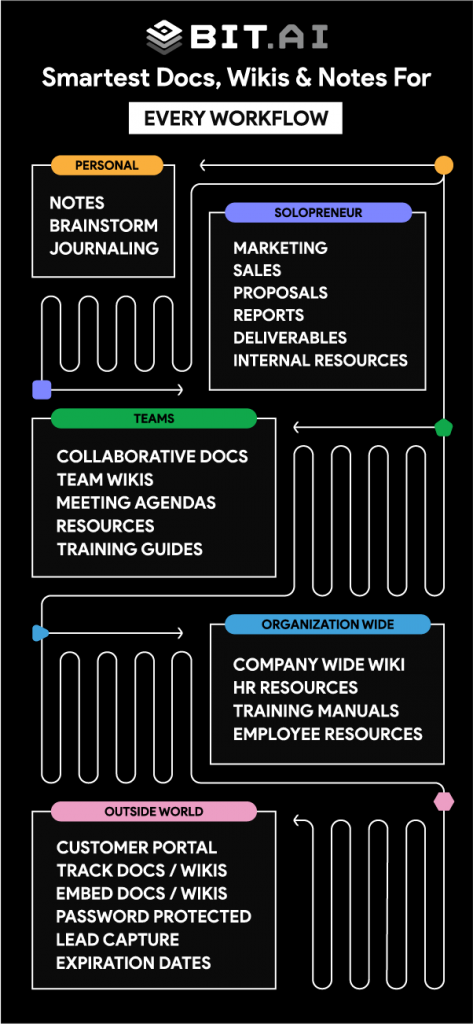Welcome to the exciting world of knowledge management! It’s not just a boring corporate buzzword – it’s a superpower that can take your organization to new heights!
Think of knowledge management as a secret weapon that allows you to harness your team’s collective knowledge and expertise to drive success and growth. It’s like having a team of superheroes, each with their own unique skills and powers, working together towards a common goal.
And the best part? According to a study by McKinsey, organizations that effectively manage their knowledge can improve productivity by up to 25%! That’s like having an entire extra day of work each week.
So, how does it work? Knowledge management involves creating a central information hub, like a supercharged database or wiki, where employees can easily access and share knowledge. It also encourages knowledge-sharing through training and collaboration programs, so your team can learn from each other and grow together.
And with the right technology, knowledge management can be a breeze! You can automate processes, streamline communication, and make sure everyone has access to the information they need when they need it.
So, put on your superhero cape and embrace the power of knowledge management, as it’s the key to unlocking your organization’s full potential!
What is Knowledge Management Process & What is its Purpose?
Knowledge management is the systematic process of creating, capturing, storing, and sharing knowledge and expertise within an organization. It involves identifying valuable knowledge, organizing it, and making it easily accessible to those who need it. The process includes methods for collecting and documenting knowledge, such as through databases, wikis, and other knowledge repositories. It also involves encouraging knowledge sharing and collaboration and leveraging technology to automate knowledge management tasks. Knowledge management aims to improve an organization’s performance by leveraging its members’ collective knowledge and expertise.
Its purpose is to help employees make better decisions, perform their jobs more effectively, and spark fresh ideas. It’s all about tapping into the wisdom and expertise of individuals and making it easily accessible to everyone who needs it and by encouraging sharing and learning, this process promotes collaboration and innovation. It’s like having a treasure trove of knowledge within reach, where you can find answers, learn from past experiences, and avoid repeating mistakes.
Now that you know the knowledge management process, let’s explore its benefits and discover how it drives innovation and improves organizational performance.
Benefits of the Knowledge Management Process
Knowledge is power, and implementing Knowledge Management processes is the key to unlocking that power within your organization! Knowledge Management processes can help you capture, store, share, and apply knowledge and expertise to achieve your goals. Plus, they come with some awesome benefits, such as:
- Increased efficiency: Say goodbye to wasting time on duplicated efforts and endless rework. Knowledge Management processes streamline decision-making and boost productivity, giving you more time to do the things you love.
- Improved innovation: It’s time to bring your ideas to life! Knowledge Management processes foster a culture of innovation and creativity by encouraging the sharing of best practices and lessons learned.
- Enhanced knowledge sharing: Communication is key, and Knowledge Management processes make it easy to share knowledge, expertise, and best practices across your organization. Collaboration has never been so easy!
- Reduced risk: Losing valuable knowledge when employees leave the organization is a thing of the past. Knowledge Management processes preserve critical knowledge and expertise, mitigating the risk of losing valuable insights.
- Increased competitiveness: It’s time to gain an edge in the marketplace. Knowledge Management processes help you leverage your knowledge and expertise to stay ahead of the competition.
And suppose that’s not enough to convince you; here’s a mind-boggling fact: according to a study by McKinsey. In that case, knowledge workers spend up to 20% of their time searching for information, costing organizations billions of dollars in lost productivity each year. With Knowledge Management processes in place, you’ll save time and money while empowering your team to do their best work.
Knowledge management processes bring a wealth of benefits to organizations, boosting productivity, fostering innovation, improving efficiency, increasing competitiveness, and managing risks, all while reducing costs and preserving vital knowledge.
Now that we are familiar with these benefits let’s dive into the next section to uncover the essential components of the knowledge management process flow, providing a deeper understanding of how it all comes together.
The Key Components of the Knowledge Management Process Flow
Knowledge management is becoming an increasingly important concept in the modern workplace. As companies strive to remain competitive in an ever-changing business environment, they realise that their most valuable asset is the knowledge and expertise of their employees. Implementing an effective knowledge management process can help companies capture, store, and share this knowledge, improving decision-making, increasing efficiency, and driving innovation.
But how do you implement a knowledge management process? It all comes down to structure, culture, people, process, technology, and continuous improvement. Let’s explore these 6 components in more detail to understand how they fit together to create an effective knowledge management process.
1. Structure
First up, structure. This means creating a knowledge management strategy, identifying knowledge sources and repositories, developing knowledge sharing and collaboration platforms, establishing roles and responsibilities for knowledge management, and measuring and evaluating your initiatives. Think of it as the blueprint for your knowledge management process.
2. Culture
This is about developing a culture of knowledge sharing and learning, encouraging open communication and collaboration, promoting a learning mindset and continuous improvement, recognizing and rewarding knowledge sharing and innovation, and building trust and a sense of community among your employees.
3. People
This means identifying knowledge champions and leaders, building a knowledge management team, providing training and development opportunities, encouraging employee participation and engagement, and building a diverse and inclusive workforce.
4. Process
The process involves identifying and capturing knowledge, organizing and categorizing knowledge, sharing and distributing knowledge, using knowledge for decision-making and problem-solving, and documenting and archiving knowledge.
5. Technology
Technology is an essential component of knowledge management. This means selecting appropriate technology platforms, integrating and customizing technology tools, providing access to knowledge repositories and databases, ensuring data security and privacy, and monitoring and evaluating technology usage and effectiveness.
6. Continuous Improvement
Finally, continuous improvement means measuring and evaluating your knowledge management initiatives, identifying areas for improvement, implementing changes and adjustments, continuously learning and adapting, celebrating successes, and recognizing achievements.
An effective knowledge management process is critical for companies to harness the power of their employees’ knowledge and expertise. By implementing the key components of structure, culture, people, process, technology, and continuous improvement, companies can create a culture of knowledge sharing and learning, improve decision-making and efficiency, and drive innovation. It’s important for companies to continuously evaluate and improve their knowledge management process to ensure it remains relevant and effective in the rapidly evolving business environment.
Implementing a knowledge management process may seem daunting for small businesses, but it doesn’t have to be. By following our key components, small businesses can develop an effective knowledge management process that meets their unique needs and resources. Let’s look at some specific steps small businesses can take to implement a knowledge management process.
Steps for Knowledge Management Process for Small Businesses
Now that you know the key components, how do you implement a knowledge management process for your small business? Here are the 7 steps to follow:
1. Assess Knowledge Management Needs and Goals

Before you can begin a knowledge management process, it’s important to understand your business needs and goals. What knowledge do you need to capture and share, and why is it important? Consider your business’s specific challenges and opportunities and how knowledge management can help address them.
2. Identify Knowledge Sources and Repositories
Once you know what knowledge you need to manage, identify where it resides. This could include documents, databases, individuals, and other sources of information. Creating an inventory of your knowledge sources will help you determine how best to capture and share that knowledge.
3. Develop a Knowledge Management Plan and Strategy
Based on your needs and sources of knowledge, develop a plan for managing that knowledge. This might include policies and procedures for capturing and sharing knowledge, employee roles and responsibilities, and technology tools for storing and accessing knowledge.
4. Implement Technology Platforms and Tools
Technology is essential to knowledge management, and many tools are available to help small businesses manage their knowledge. This might include a content management system, a customer relationship management system, or a social intranet. Choose the technology that best meets your business needs and budget.
5. Build a Culture of Knowledge-Sharing and Learning

To ensure the success of your knowledge management process, you need to create a culture that values knowledge sharing and learning. This means promoting open communication, collaboration, and a continuous improvement mindset. Encourage employees to share their knowledge and provide opportunities for them to learn from others.
Read More: Top Knowledge-Sharing Methods for Enhanced Productivity & Innovation!
6. Provide Training and Development Opportunities
To support a culture of knowledge sharing and learning, provide employee training and development opportunities. This might include formal training programs, mentoring, or peer-to-peer learning. Encourage employees to take ownership of their learning and development.
7. Measure and Evaluate Knowledge Management Initiatives
Finally, it’s important to measure and evaluate the effectiveness of your knowledge management process. This will help you identify areas for improvement and make changes as needed. Regularly review your policies, procedures, and technology tools, and solicit employee feedback to ensure that your knowledge management process meets your business needs.
Implementing a knowledge management process can help small businesses capture and share their valuable knowledge, leading to better decision-making, increased efficiency, and improved innovation. By assessing your needs and goals, identifying your knowledge sources and repositories, developing a knowledge management plan and strategy, implementing technology platforms and tools, building a culture of knowledge sharing and learning, providing training and development opportunities, and measuring and evaluating your initiatives, you can create a successful knowledge management process for your small business.
After setting up the knowledge management process in your business, it is time to focus on the challenges you may face during the early period. In the next section, let’s discuss these challenges, and we will also talk about how you can overcome them!
As organizations seek to enhance their competitiveness in the modern business landscape, implementing a knowledge management process has become increasingly crucial. However, it is important to note that organizations face common challenges while implementing a knowledge management process. These challenges can derail the process and fail to achieve desired results. This section will explore the 5 common challenges organizations face and provide solutions to address them.
Common Challenges in Knowledge Management Process
1. Resistance to Change and Adoption of New Practices
One of the most common challenges in implementing a knowledge management process is resistance to change. Employees may be comfortable with their current practices and may not see the value in adopting new approaches. To overcome this challenge, it’s important to communicate the benefits of knowledge management and involve employees in the process. Training and development opportunities can also help employees to develop the necessary skills and confidence to adopt new practices.
2. Lack of Leadership and Commitment
Implementing a successful knowledge management process requires strong organizational leadership and commitment. Without this, employees may not take the process seriously and may not allocate the necessary time and resources to support it. To address this challenge, it’s important to engage senior leadership in the process and communicate the benefits of knowledge management to all levels of the organization.
3. Siloed Organizational Structure and Lack of Collaboration
Knowledge management requires a culture of collaboration and open communication, but this can be difficult to achieve in organizations with siloed structures or where collaboration is not a priority. It’s important to break down silos and encourage cross-functional collaboration to overcome this challenge. This can be done through team-building activities, shared goals and objectives, and the development of collaborative tools and platforms.
Read More: Knowledge Management: What is it & it’s importance!
4. Limited Resources and Budget Constraints
Implementing a knowledge management process can require significant time and resources, which can challenge small businesses or organizations with limited budgets. To address this challenge, it’s important to prioritize knowledge management initiatives based on their potential impact and to seek out cost-effective solutions, such as open-source software or cloud-based platforms.
5. Data Security and Privacy Concerns

Finally, data security and privacy concerns can be a major challenge in implementing a knowledge management process. Establishing clear data management policies and procedures is important, and ensuring employees are trained on these policies. Using secure technology platforms and regularly monitoring and reviewing access and permissions can also help to mitigate security risks.
Conclusion
Knowledge is power, and managing that knowledge can be super exciting! By capturing, organizing, and sharing information effectively, you can unlock new levels of success for your business. Let’s journey through the amazing world of knowledge management and see how it can benefit your organization.
First, imagine a world where you never have to waste time searching for information or reinventing the wheel. With a successful knowledge management process, you can easily access relevant information and best practices, saving you time and energy. You can make informed decisions faster and with greater confidence, leading to even greater success for your business.
And what about innovation and creativity? With a culture of knowledge sharing and learning, your team can collaborate and brainstorm new ideas more effectively. You can create a space where everyone’s ideas are valued and can contribute to the organization’s success.
By recognizing and rewarding innovation, you can create a culture where everyone is encouraged to think outside the box and develop creative solutions.
Let’s not forget about the benefits to your customers. With a knowledge management process in place, you can improve customer satisfaction by quickly and efficiently resolving their issues. You can also give them the information they need to make informed decisions about your products or services, building trust and loyalty.
And who doesn’t love happy employees? By providing training and development opportunities and encouraging employee participation and engagement, you can create a workplace culture where everyone feels valued and invested in the organization’s success. This can improve employee retention and job satisfaction, ultimately benefiting the organization.
So, let’s get started on implementing a successful knowledge management process! By identifying your organization’s needs and goals, building a team of knowledge champions, and implementing the right technology and tools, you can create a process to help your organization thrive and achieve its goals. And remember, knowledge is power, so let’s harness that power and take your organization to the next level!
Further Reads:
Knowledge Sharing at the Workplace For Enhancing Productivity
Knowledge Management System Guide For Better Sales
Internal Knowledge Base For Businesses
Best File Management Systems and Software in 2023
9+ Benefits of Collaboration For Teams and Businesses!

Related posts
Bit.ai | Watch to Learn More
What is Bit.ai?
Bit.ai is an innovative AI-driven knowledge and Document Managment suite designed to empower knowledge workers by streamlining the creation of, documents, wikis, and notes. With an intuitive interface and seamless integration, Bit.ai acts as a versatile assistant to help you collaborate, generate, organize, and visualize your ideas effortlessly. Whether you are drafting a report, managing a project, collaborating with your team or clients, or brainstorming new concepts, Bit.ai brings intelligence and creativity to every aspect of your work process.


